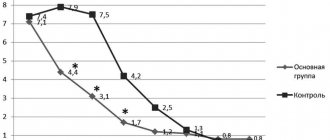Chemical characteristics
Topiramate, having the empirical formula C12H21NO8S, is a fructose derivative and has a complex chemical structure with a high molecular weight of 339.33 units. In pharmacology, it is classified as a group of drugs with antiepileptic properties. In clinical pharmacology, it belongs to the group of anticonvulsants with nosological classification ICD-10 - G40 Epilepsy.
In terms of external indicators, the chemical substance Topiramate is characterized as a powder consisting of white crystals that taste bitter. Liquids that dissolve powder without sediment:
- ethanol
- acetone
- dimethyl sulfoxide
- chloroform.
Pharmacological properties
The work of Topiramate as an antiepileptic drug is based on the principle of reducing the firing frequency of neurons. The drug is characterized by selectivity in relation to the pathology of neuronal activity and inhibition of their activity. Three main pathways underlie the action of the drug:
- By raising the tone of GABA receptors, it activates inhibitory neurons.
- By reducing the dynamics of NMDA receptors, it inhibits the excitation of neuronal receptors.
- Direct action on the receptors leads to the creation of an electrical impulse, due to which the ion channels of neurons are regulated.
Topiramate is used to treat epilepsy
Topiramate's ability to block sodium channels with suppression of the possibility of secondary impulses caused by potential differences on depolarized neuron membranes is characteristic of all antiepileptic drugs belonging to the class of sulfate-substituted monosaccharides.
Clinical and pharmacological research
Topitramate is a complex chemical compound
When observed in a clinical setting, Topiramate is prescribed to eliminate tonic-clonic or partial seizures. It is prescribed for monotherapy, as well as in combination with other anticonvulsants as additional therapy aimed at relieving the symptoms of Lennox-Gastaut syndrome in the initial diagnosis of epilepsy.
The rate of drug excretion by the genitourinary system is not related to age category and completely depends on the functionality of the renal system.
If renal function is impaired, there is a decrease in plasma and renal clearance of Topiramate to CC levels <60 ml/min with an increase in the time when the equilibrium state is reached. This process can take up to two weeks, compared to a week's recovery for patients with a healthy kidney system.
Indications for use
Indications for the use of the drug are the following factors:
- Newly diagnosed epilepsy
- Lennox-Gastaut syndrome
- Alcoholism syndrome
- Post-traumatic stress
- Obesity
- Neuropathy
- Migraine*.
* Topiramate is prescribed as a prophylactic measure to prevent migraine in adults, but the use of the drug in acute attacks of the disease has not yet been studied. Contraindications include hypersensitivity of the patient's body to the active substance.
Effect of the drug
Topiramate. Pills
Topiramate is an anticonvulsant aimed at antiepileptic action by relieving muscle cramps. The drug is also effective in the treatment of various manifestations of psychosis, as an antimanic agent in bipolar disorders of the nervous system, including manic-depressive forms of psychosis.
The range of applications of Topiramate includes:
- stress of various origins, for example post-traumatic stress
- alcoholism
- binge eating
- headaches of various etiologies
- neuropathy.
The special qualities of the drug include the ability to stabilize mood, since it is classified as a normiotics. Thanks to all the above qualities, Topiramate is included in the list of important and vital medicines.
Effect of the drug on cell mutation
Clinical observations were carried out on laboratory rats and mice, so there is no data on the effect of the drug on the human body as a carcinogen. By testing the drug in vivo and in vitro in laboratory conditions at research sites, Topiramate showed neither genotoxic nor mutagenic effects throughout all stages of the research.
In pathological carcinogenicity studies, three experimental groups of mice were administered Topiramate at 20, 75 and 300 mg per kilogram of body weight for 21 months. In a group of mice receiving 300 mg/kg of the drug, cases of bladder tumor formation were observed in both males and females.
The mouse bladder is a unique smooth muscle excretory system, similar in its histomorphological structure to human organs. In this group of mouse wards, the level of the active substance in the plasma ranged from 50 to 100% of the equilibrium concentration, which corresponds to similar indicators during monotherapeutic treatment with Topiramate in humans, but there was no data on the effect of the drug on the human body as a carcinogen.
Studies have documented certain effects of the drug on pregnant rats and mice.
As a result of experiments during the period of organogenesis, the likelihood of obtaining offspring with congenital deformities, mainly with craniofascial defects, increased significantly. The deformities were passed on to subsequent generations in a progressive form. In this group of experimental subjects, the following was already observed in the descendants:
- micromelia
- ectrodactyly
- Amelia.
Topiramate. Tablets 25 mg
In the group of experimental rats where the dose was increased to 500 mg/kg, the results of observations were: significant depression of weight in the pregnant female, ossification and reduction of the skeleton of the embryo.
In a group of experimental rats and mice, with a dosage of the drug up to 20 mg/kg, the offspring showed both a decrease in the weight of the fetal embryo and disturbances in the structural structure of the skeleton.
